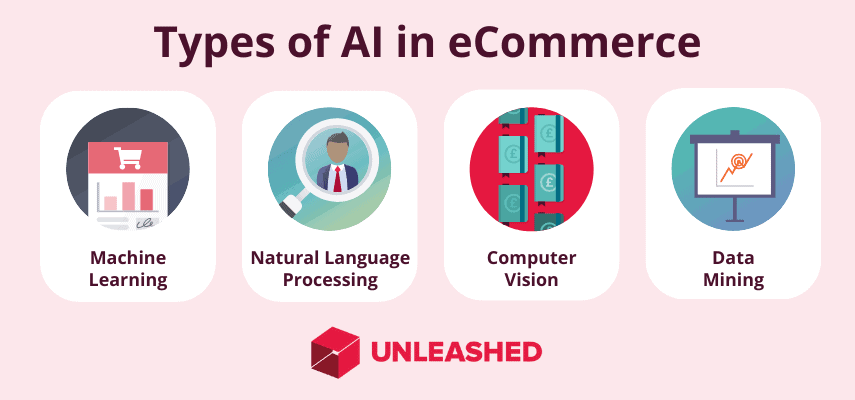
Artificial intelligence (AI) is changing the game for online businesses.
Shoppers can now enjoy more personalised buying journeys, as merchants make it faster and easier to find the products that they’re most likely to purchase. Goods are being produced, procured, and delivered more efficiently with reduced costs. And to put icing on the cake, predicting future product trends and consumer demand has never been easier thanks to new AI tools.
In short, your entire supply chain can benefit from the use of AI in eCommerce.
This article looks at the existing use cases and benefits of artificial intelligence for eCommerce businesses, the risks it presents, and what the future may hold. Let’s dive in.
How AI in eCommerce is reshaping the industry
From generative tools like ChatGPT to industrial robots and customer support chatbots, the eCommerce sector has embraced machine learning and other forms of artificial intelligence – perhaps more readily than most industries.
Today, AI in eCommerce is everywhere:
- Shopify has rolled out AI-generated product descriptions
- Sephora partnered with Google to bring voice search to the online beauty space
- Amazon recently released Amazon Q – an AI-powered assistant
This comes as no surprise, given the rapid rise of eCommerce and its close ties with modern solutions such as software-as-a-service (SaaS) applications and web-based marketing.
These examples are just the tip of the iceberg. The global AI software market is expected to increase to USD 126 billion by 2025, according to data from Statista.
As we’ll get into shortly, the opportunities to implement AI in eCommerce are growing by the day. But with every hyper-advanced AI solution comes new concerns and risks we must keep in mind.

Benefits of artificial intelligence in eCommerce
A study conducted by Bloomreach recently found that 64% of commerce leaders agree AI can give businesses a distinct competitive advantage and boost customer experiences.
However, because AI in eCommerce may still be in its infancy, many brands remain uncertain about the advantages of investing in an artificial intelligence strategy. We’ve listed some of these advantages below to help educate those of you still feeling a bit in-the-dark about this new wave of technology.
The benefits of artificial intelligence in eCommerce include:
- Increase productivity: AI can automate ordinarily manual tasks in your eCommerce workflow to improve efficiency and streamline operations while reducing your reliance on human labour.
- Generate more sales: Hyper-targeted AI marketing tactics and AI-powered customer support can help you get more sales, improve your brand’s reputation, and avoid missed opportunities with potential customers.
- Improve customer loyalty: AI in eCommerce helps reduce churn by analysing customer behaviour across your sales channels and offering insights for ways to optimise the brand experience and keep customers loyal.
- Reduce operational costs: AI-powered workflows are highly automated, saving you time and money that can be redistributed to more needful areas of the business.
- Mitigate risk of fraud: Fraud-detection tools powered by AI will help you minimise the risk of fraudulent behaviour in your store and can bolster the security of your website.
- Create a more personalised brand experience: Enabling AI to strengthen your branding and communications by personalising recommendations and messaging may lead to better positioning and more compelling brand experiences for shoppers.
How is AI used in eCommerce? 7 common use cases
There are dozens of examples and use cases of AI in eCommerce – more than we have time to discuss today. But as Raj De Datta, CEO of Bloomreach, recently put it:
“It’s easy to be overwhelmed by all that AI can do, but its future potential shouldn’t overshadow its immediate power. Start with what you have—smaller use cases like content creation or SEO. And if you’ve already covered these use cases, think bigger.”
AI in eCommerce can be broken down into four main categories:
- Machine learning
- Natural language processing (NLP)
- Computer vision
- Data mining
Here we look at seven of the leading use cases for AI in eCommerce.

1. Dynamic pricing
Dynamic pricing is pricing strategy that’s existed for some time in the online travel space – famously executed internally by Amazon. Now, it’s slowly becoming a staple of ordinary online retail as well.
Put simply, dynamic pricing is the automation of pricing adjustments. It involves employing data-driven algorithms to regularly optimise product prices based on real-time customer behaviour, supply and demand trends, competition, and input from the merchants.
Dynamic pricing uses the power of AI to predict ideal windows for discounting goods and to determine the optimal price reduction required to increase sales. In doing so, it enables companies to achieve always-on competitive pricing without requiring manual input.
2. Inventory management
Inventory management can feel like a constant battle for eCommerce retailers.
In particular, the struggle to maintain optimal stock levels for an ever-shifting consumer demand while avoiding overstock issues never stops.
Now, however, AI is transforming the way eCommerce merchants approach demand forecasting.
Inventory optimisation software, such as Unleashed’s Advanced Inventory Manager module, ensures inventory availability and prevents overstock by leveraging artificial intelligence to predict future demand for products based on historical sales data and market trends.
In this video, Sam Walker of Flowstore explains how AI-powered inventory management has improved their replenishment strategy.
Are you ready to optimise your stock levels with Unleashed + AIM? Start a free 14-day trial today to see if it’s right for you.
3. Customer support
One of the most popular applications of AI in eCommerce comes in the form of chatbots and virtual assistants.
Fast responses are highly valued by today’s online shoppers – and time spent waiting for a reply to a product inquiry can lead to shopping elsewhere. It’s no wonder, then, that NLP and generative AI are being implemented to help businesses deliver instant, automated responses through on-page chatbots and assistants.
There are multiple applications for AI-powered chatbots in eCommerce, including:
- Enhancing the checkout window to answer last-minute queries and prevent cart abandonment.
- Providing a 24/7 customer support option for customers browsing outside of regular trading hours.
- Collecting information about customers that can be used to inform future product development and marketing decisions.
- Streamlining customer communications and minimising the reliance on human staff.
In addition to chatbots and virtual assistants, AI can also be found in customer relationship management (CRM) software – used to sift through large swathes of information to identify hidden trends and insights.
- Try for free: Inventory Software with CRM integration
4. Cybersecurity and fraud prevention
AI-powered fraud detection tools can help eCommerce merchants prevent fraudulent activity on their websites. In 2021 alone, the total value of fraudulent card payments reached USD 32 billion – and is expected to reach USD 38.5 billion by 2027.
These new solutions use machine learning algorithms to detect and prevent fraudulent transactions and to continuously improve the accuracy of those detections over time. This last function represents the major benefit of using AI to combat fraud: as scammers continue to develop new ways to enact fraud, artificial intelligence can “teach itself” new rules to prevent threats it has never seen before.
5. Tailored shopping experiences
Artificial intelligence can also be used to help shoppers find the right products and guide them smoothly through their eCommerce journey. It enables businesses to be more targeted with their websites by intelligently recommending the products they’d most likely be interested in buying. In this use case, the AI crunches data points such as purchase history, search behaviour, and browsing habits to determine which products are best suited to each website visitor.
Common examples of AI-powered recommendations include product page widgets and pop-ups like “People also bought” or “Customers also viewed” suggestions.
6. Generative AI in eCommerce (content and design)
Another example of where generative AI may be useful in eCommerce is in the production and analysis of a company’s website and marketing materials.
Generative AI tools can be used in eCommerce to:
- Write product descriptions
- Generate copy and images for marketing materials
- Tailor a digital experience to each customer
- Give feedback on brand communications and positioning
Tools like DALL-E and ChatGPT are already well known, but there are 100s of alternatives now available – and many existing tools (such as Grammarly and Shopify) are already finding ways to inject the generative AI functionality into their offerings.
7. Marketing optimisation
Audience segmentation is a highly effective tactic for optimising your marketing efforts.
Artificial intelligence tools can be used to analyse your customer data and instantly create customer segments based on similarities that may be unobvious (and time-consuming) under a manual investigation. This allows you to deliver highly tailored marketing emails and advertisements to potential customers that have a much greater chance of leading to a sale.
Using AI in eCommerce marketing will also help you better understand your audience – their interests and habits – so you can better align your brand with the characteristics of your target customers.
Risks of implementing AI in eCommerce
- You’re removing the human element. While AI can help provide a personalised experience to customers, it can also make them feel like they’re talking to a robot – particularly when it fails to grasp the nuances of how humans naturally communicate. Reliance on AI tools can also lead to trouble, as algorithms are rarely perfect and work best with real human input.
- It can be a costly investment. While some are free, many modern AI eCommerce solutions are expensive to implement and come with hefty subscription fees. There is also a cost to learning how to use AI tools correctly. These expenses can dig into your bottom line, hurting your company’s profitability.
- There are data privacy and cybersecurity risks. Because machine learning AI collects customer data to make predictions, it can present a security risk that may lead to information leaks or data breaches. Instances of this occurring are not uncommon – even Amazon’s latest AI tool has come under fire recently for potential leaks.
- Ethical and legal challenges. Many AI tools lack transparency and their decisions are not always obvious to humans. Artificial intelligence may be susceptible to biases learned accidentally or taught by humans that can lead to difficult regulatory and moral challenges that must be carefully navigated.

5 tips for using AI in eCommerce
If you’re an eCommerce merchant ready to invest in AI, it’s worth your time to get acquainted with the best practices and risk-mitigation strategies for successful deployment.
Here are our top five tips for using AI in eCommerce:
- Define your goals and objectives
- Identify the costs, time, and stakeholder involvement you’ll need
- Focus on business efficiency and customer experience
- Avoid getting shiny object syndrome
- Regularly assess and audit AI-powered workflows
1. Clearly define your business goals and objectives
Before you invest in any new eCommerce software – AI-powered or otherwise – it’s important to know why you’re investing.
What problems are you trying to solve with AI?
How will the options you’re considering help solve those problems?
Is there a clear ROI?
Work with your team to identify your primary goals for using AI in eCommerce. These will help justify any investment and be important to track once you’ve added new AI to your workflows.
2. Understand the requirements to implement new technologies
Implementation and training for new systems are not always straightforward. In addition to the costs and time required to get up and running, there may also be regulatory concerns you’ll need to address. For example, if you’re using AI to collect and analyse customer data you may be required to update your company privacy policy.
3. Prioritise tools that will enhance business efficiency and customer experience
The AI playing field is broad and all-encompassing. There are artificial intelligence solutions for stock control, manufacturing, customer support, marketing… the list goes on.
Focus on the tools that will bring the most value to your company. This usually means looking for solutions that ensure you deliver excellent customer service while streamlining your workflows to bring costs down.
4. Don’t get carried away by shiny object syndrome
Following on from the previous tip, beware of shiny object syndrome. This is when we (fallible humans that we are) get distracted by new and modern innovations – so much so that we end up paying for a whole bunch of products that don’t deliver any real value to the business.
Before you dive into a contract with a new SaaS tool or purchase the latest in warehouse robotics, make sure you’re doing it for the right reasons. Ask yourself: Will this actually solve any of the problems I'm trying to solve?
5. Monitor and audit your AI-powered workflows
Once new eCommerce AI has been added to your processes, don’t get too comfortable.
Carefully monitor how effectively it’s enhancing those workflows and whether it is helping to achieve your desired outcomes.
In many instances, AI will be able to improve itself over time. With a little input from real humans, it can be shaped and guided to more closely meet your needs as time goes on and more data has been collected.

The future of AI in eCommerce
The future looks bright for AI in eCommerce. More and more solutions are being developed to solve everyday problems and simplify the process of buying and selling goods online.
In a recent report by ResearchGate, professors Aisha Mohdhar and Khaled Shaalan predicted that using AI “to solve the issue of last mile approach i.e. the seamless process of end-to-end delivery in the supply chain” will be at the top of every eCommerce organisations' list by 2030.
Researchers from McKinsey & Company believe generative AI could add USD 150–275 billion to the apparel, fashion, and luxury sectors’ operating profits in the next three to five years.
While AI is already being deployed to improve demand forecasting, customer experience, and marketing personalisation, there are plenty more ground-breaking innovations yet to be released.
Search-based eCommerce has been rapidly rising in popularity and sway. AI developments from companies like Google, Shopify, and Microsoft to further empower targeted online search practices may soon see highly engaging online shopping experiences custom-fit for each consumer.
In summary, we can expect to see more opportunities to deliver exceptional online shopping experiences – and businesses will likely continue to improve the efficiency of their operations – as AI works to further boost productivity, reduce waste, and eliminate errors.
